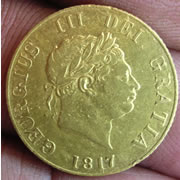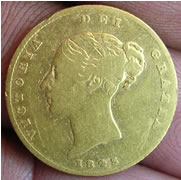

Metal detecting holidays in England with the World's most successful metal detecting club.
Twinned with Midwest Historical Research Society USA
Archived News Sept 1st 2007 to 23rd Oct 2008 |
||||||||||||||||||
 |
||||||||||||||||||
23rd Oct 2007 Great finds and updates - new video posted I have posted the latest 'finds from the field' video to the members forum and it includes the oldest coin ever found here. Some more great finds made yesterday including this exciting Medieval silver ring brooch inscribed with a heart and two letters, possibly a love token ?. I am playing with a whole series of bronze artefacts including what looks to be a bronze roman key not in the reference books. All the pieces will be going off shortly to the museum for evaluation. I will be posted them to the latest hunt page Oct 2007 finds page 3. We also got another couple of new 17thC trade farthings for our collection, 1666 James Bonun of Sisted in Essex and the William Newman posted below. These are such neat artifacts as you get generally the date, guys name and his place of trade.
17thC William Newman of Halstead Essex hammered copper trade farthing I have still got a back log of finds to post and will try and get some more posted shortly.
13th to 15thC English Medieval silver ring brooch - inscribed with a heart and RU - reported to museum as treasure 1.76g,
27.45mm dia
This season we have found an exceptional number of stunning 1649 Commonwealth hammered silver finds that I have just posted to the Charles 1st page at the bottom. This is a facinating period of British history with the English Civil war and chopping the head of the King. I have just updated the forum competition page with the latest hammered silver count that now stands at 105, check your guess here for the free weeks holiday.
|
||||||||||||||||||
21st Oct 2007 It's official, oldest coin ever found here - Stunning hammered groat
Roman Republican silver coin 126 BC 3.50g, 17.12 mm Basildon Mark has found the oldest coin ever found here, our current oldest coin was 118BC. It is Mark's first one so what a way to start your collection, great find. Mark Lehman has just sent back his ID and views. 'This one is a Roman Republican
denarius of tribune/moneyer N. Fabius Pictor, struck at Rome in 126 B.C
(RSC/Babelon - Fabia 11), . This is another really interesting piece, not unlike the odd Greek coin you occasionally turn up, because despite its worn state - showing it was in circulation for quite some time - it's really "too early" of a piece to be in Britain. Unless, somehow, this piece was carried ashore by one of the soldiers of Julius Caesar's ill-fated British expeditions - at which time it would have been nearly 75 years old - it would have had to be bartered for tin or other trade-goods in the pre-Roman era or been part of some hoard or treasure which had been accumulated on the mainland and later transported to Britannia. It would have been very unlikely to be a circulating coin at the time of Claudius' successful invasion - at which time it would have been nearly 175 years old. So, you're left with it either travelling to Britannia by means unknown c. 100-60 B.C., or possibly having been held as an old and curious good luck piece or similar item by a much later' Roman Mark A lot of early long cross hammered silver is turning up including this stunning Edward III groat below. I have posted more silver and finds to the latest hunt page. I have completed another video of the guys out their finding stuff and will upload to the members area later.
1351-2
Edward III hammered silver groat - Series C, Cross 1 Annulet stops, Standard
type F
4.51g, 26.73mm obv EDWARD DG ANGL rev CIVITAS LONDON - City of London mint |
||||||||||||||||||
20th Oct 2007 Lots of new land ploughed and rolled - Roman ID's back
A complete Romano-Britsh protected loop terret. The loop through which the reins would have passed remains. This consists of a sub-circular sectioned D-shaped attachment loop that is situated beneath a triangular ‘skirt’ that comes down over the loop to the front and back. At each side the skirt ‘flicks-up’ rather like a jesters hat. There are a number of these types of terrets known from Norfolk including the examples from Beighton and Tatterset (31569 and HER 33975). 44.61g, 45.75mm L x 32.50mm H x 28.28mm H
Protected loop terrets are usually considered to be Roman and dating to the late first and second centuries AD
Complete 17thC decorated sword hanger - 3 rivet fixing Mark Leham has just sent back the ID's of all the outstanding Roman bronze finds, great info and very interesting background to the finds.
Gallienus 260-268 A.D 2.49g, 20.72mm 'is a mid-late
3rd century AE antoninianus. The denomination was introduced, in good
silver, in 215 by Caracalla - it contained one and one-half denarius'
worth of silver but was tariffed as 2 denarii - things only got worse
from there. Quickly debased, by the time of the crisis of the 260's, it
was completely copper with a silvery wash (which seldom survives). The
later 3rd century "Illyrian" emperors like Aurelian and Probus
restored the coin to a better size and alloy, and although still silver-washed,
the process was better so it stuck better. Eventually, it was phased out
in Diocletian's reforms in the late 280's, but a new, wholly AE "radiate"
fraction of the follis was retained with exactly the same reverse types
as the former antoniniani. I guess everyone was so used to having copper
radiates that they just continued the general module as a different denomination.
Magnentius 350-353 A.D 1.57g, 17.71mm This seems
to be either a centenionalis which has been extensively chipped making
it smaller than it started out, or perhaps it's a half-centenionalis.
Since none of the obverse legend remains, it could be either Magnentius
or Decentius and I won't be able to tell which of the two (although Magnentius'
coins are far more common). This
Constantine
335 A.D 1.65g, 16.19mm 'This is
a "City Commemorative" - when Constantine moved his capitol
to Constantinople in about 330 A.D., he issued coins in honor of both
Constantinople and of Rome. This one is the CONSTANTINOPOLIS type with
Commodus 184 A.D 6.04g, 23.64mm Thus is an
As of Commodus. This son of Marcus Aurelius was a fairly crazy bad guy
who should never have been emperor, but wasn't probably quite the craven
wacko that Joaquin Phoenix portrayed him as in the colorful but wildly
historically inaccurate "Gladiator" - for one thing, he certainly
didn't kill his father to become emperor - he had been co-emperor since
177 A.D. - 3 years before Aurelius' demiseCommodus did, in fact, appear
in the arena in his later life - slaughtering wild beasts - and apparently
thought he was Hercules re-incarnate.The obverse reads (or should) : M
COMMODVS ANTON AVG PIVS. Laureate head right. -
Severus Alexander 222-235 A.D. 3.36g, 20.26mm This one
is an As too, but has neither enough legend nor a characteristic enough
portrait for me to be sure which of the two most likely candidates it
is, but I believe it's either Severus Alexander 222-235 A.D. or Gordian
III, 238-244. Both were "boy emperors" who came to the throne
in their teens and were both around a relatively long time as mid 3rd
century emperors went - long enough for there to be a significant body
of coins for both of them. Also, the one letter on the obverse which appears
to be clear seems to be an "A" - and could fit into either of
their names in about that position. I'm afraid I can't tell what's happening
on the reverse of this one. Sorry I can't give you much more than that
on the basis of the photos.
Constantine 335-337 A.D 1.38g, 14.06mm Thus is another GLORIA EXERCITVS - this one is from the mint at Trier, although I can't tell you which of the Constantinians is on the obverse. The ones with a single standard between the soldiers date mostly to the period 335-337 A.D. or shortly thereafter. This is probably one of the 3 sons of Constantine, probably as Caesar just before Constantine's death.
Aurelian - 270-275 A.D 2.08g, 17.59mm
Magnentius ID 3.28g, 19.93 mm This one
is either Magnentius or Decentius again - and again, no legend is visible
so there's no way to be sure which of the two it is, although Magnentius
is a good bit more likely. This is another Centenionalis, and shows clearly
the sympathies of the Western Augustus and Caesar for Christianity - there
was a good bit of disagreement over just how good an idea Constantine's
choice of Christianity was at the time. The Chi-Rho reverse on this and
the contemporary double-centenionalis left little doubt about the official
position of Magnentius & Decentius. Mark |
||||||||||||||||||
19th Oct 2007 Excellent days detecting - 9 hammered silver and nice do dads - more slots There is an usual demand for hunts this November so I have had to open up more accommodation on the availability page . There is just one slot left of the week commencing 2nd November and 2 slots on the 9th Nov if you fancy joining the guys. This year we are detecting to the 4th December as we have silly amounts of land to try and cover this season. Some really nice hammered silver and copper coins are turning up including this magnificent James 1st Shilling found by Cal Dave. The Elizabeth 1st coin is an unusual denomination to find, three farthings, one and a half pence, just slightly bigger then the common penny. Some first's for us here to add to our 17thC Hammered copper collection , 1664 William Hurbert of Harwich Essex , 1669 Weymouth Dorset - Francis Reed, Grocer, 1662 Jacob Miller of Colchester and William Bull of Bridport Dorset, These are hammered copper trade farthings, 1/4 of a penny and issued as small change by businesses. I have posted a load of new finds to the latest hunt page click here.
|
||||||||||||||||||
18th Oct 2007 New Oct finds page - more ID's Created a new finds page Oct 2007 finds page 3 to speed up load times. Uploaded a whole new bunch of finds including a Celtic harness cheek piece and some great buttons. I will upload a load more later including a very early looking gilded clothing fastener. I really like the Tudor clothing fastener posted below with the serpents head which is listed in my fastener book but we have never found that style before with the holes to sew to a garment, really neat find. Tim sent me feedback on the unrecorded 3rd Militia button find.
'3rd Essex Local Militia gilt (b/m: Charles Jennens. London).
This is the 3rd Reg't
of the Essex Local Militia. Tim'
Stunning 16thC Tudor clothing fastener with serpents head - first one of that type found here
Really crisp 1553-4 Queen Mary hammered silver groat (4 pence)
Very rare find - Queen Anne 1711 milled silver sixpence love token in stunning condition - Late shield type
|
||||||||||||||||||
15th Oct 2007 Catching up on finds - Beautiful Roman key - more ID's More great info in
from Tim on the rare unrecorded military buttons we have found. Tim just
sent me his latest books on UK Police - Collar, Lapel & Misc badges.
Contact Tim on info@hamwichouse.com to get his on line books that cover Military and Navy buttons in great
detail.
'It still appears to be unrecorded, but my research shows a gap between 1790 & 1810 with no picture of a 6th Reg' Foot button. So for the time being, it is in my book at that spot. Still unrecorded, but
I have it in my book as the above'
'Still unrecorded, but I have it in my book as the below ' Tim
Huge bronze 1st to 4thC Roman key 48.36g, 54.94mm L x 34.45mm W x 10.33mm T
Really crisp showing mint mark, Mid 4thC Contantine Roman bronze 1.38g, 14.06mm - sent off for ID
I am going to try and catch up on last weeks finds yet to be photo'd. More great Roman's have been found on two huge new sites we are trying to hotspot and I am sending the details to Mark Lehman today for their ID. Mark thinks we have found a very serious area by this mail he has just sent . I have several Roman looking artefacts which I have already dropped into the museum for evaluation from these sites. It will be interesting to see what they ID them as. I have posted a few finds to the latest hunt page Sept 2007 finds page 2 'An astonishing group of finds - 3 nearly "uncirculated" denarii over a period of 70+ years shows significant economic action in that specific area for a long time, and by folks who evidently had just been paid with new coins - this is a very important site, a place where soldiers came to spend their money almost as soon as they had been paid (a Lupanar?) - I'd be interested to see how the Vespasian finally came out. Last image I saw, it still had a good bit of encrustation' Mark Early Pompeian excavators, guided by strict modesty of the time period, quickly classified any building containing erotic paintings as brothels. Using this metric, Pompeii had 35 lupanares. Given a population of ten thousand in Pompeii during the first century CE, this leaves one brothel per 286 people or 71 adult males. Using a stricter standard for identifying Brothels brings the number to a more realistic figure including nine single room establishments and the Lupanar at VII, 12, 18-20. Brothels during this time period were typically small with only a few rooms. The Lupanar was the largest of the brothels found in Pompeii with 10 rooms. Like other brothels, rooms in the Lupanar were plainly furnished. A mattress on a brick platform served as a bed.
|
||||||||||||||||||
14th Oct 2007 11,000BC axe head find What a tremendous eye ball find by Pennsylvania Christy off one of our Bronze age village sites, Circa 11,000 BC Middle Stone Age (Mesolithic) flint axe head. It could be possibly be Neolithic but the museum will evaluate the find. This has be a leading contender for our Find of the year.
Circa 11000 BC Middle Stone Age (Mesolithic) flint axe head - one for the museum to evaluate
|
||||||||||||||||||
12th Oct 2007 Another rare Celtic silver and more ID's What a great end to a fantastic couple of weeks with the Chicago boys. They got Celtic gold, Celtic silver, Saxon silver, Roman silver, early hammered silver plus huge amounts of great artefacts. The hunt ended on a high with a huge Roman key, large milled silvers and an amazingly crisp rarer 1554 Mary hammered silver groat, they don't get any better than this one. I reported three more treasures found to the local museum. Mark Lehamn is working on a batch of Roman bronzes I sent him for ID. We have found two new Roman areas on new land that are looking very interesting. 'I got the Hadrian photos redux a couple days back. Very impressive improvement, as I noted, and it confirms the ID as Libertas on the reverse (I think I wrote all of this to you yesterday) - but what I was curious about was the Vespasian which had been so heavily encrusted but seemed to be in such pristine condition beneath the crust. I promised Lluis, my Spanish chemist friend, that I'd send him "after" pictures of the Vespasian.
Commodus - portrayed (if not particularly accurately) by Joaquin Phoenix in "Gladiator", 6.04g,
23.64mm
I'll need to take a bit
of time with some of your new crop of photos, but I can tell you the next-to-last,
the 6 gm, 24mm piece, is an As (I think, I don't see a radiate crown at
this resolution and I don't have the time this minute to resize and tweak
photos) of Commodus - portrayed (if not particularly accurately) by Joaquin
Phoenix in "Gladiator", crazed son of Marcus Aurelius who actually
did appear over 700 times in the Colisseum, slaying exotic animals. His
last coins have him dressed in Hercules' lion-skin - he was pretty wacko
by then - see:
Also, the one you say "Interesting Reverse" about is an unusual piece - and I'm not altogether certain it's Roman - at least not normal, Imperial issue. It might be a provincial - I need to enlarge and tweak to figure out what I'm seeing. The third piece is a "CONSTANTINOPOLIS" city-commemorative of c. 330-335 A.D. with allegorical personification of The City in helmet, mantle & holding spear on obverse and Victory standing in the prow of a vessel holding a spear and leaning on a shield on the anepigraphic reverse. Your 1st piece is a late, AE anotoninianus, but I seriously doubt it's Tacitus. I'll write you more about these later'. Mark
Stunning
1554 Mary hammered silver groat (4 pence)
I just got back the ID for the silver celtic coin found yesterday from the Celtic coin index and it is another rarer one. 'Many thanks for this one. As I'm sure you already know it's a Cunobelin type, quite a scarce one too. The catalogue reference is VA 1949, and there are 29 of them in the online CCI: http://www.finds.org.uk/CCI/images-lister.php?&VA_type=1949.01 The obverse is pretty much unvaried throughout the type, with a simple CVN inscription in a panel, but the reverse has at least three different options in the placing of the inscription below the animal (which is probably a hunting dog). I think I can see the top of the M of CAM, for Camulodunum, on this one, but it will be easier to see when the coin is cleaned. I would also expect it to lose a bit of weight then, since 1.41g is about 0.15g heavier than usual for the type. I would guess the date of this type is fairly early in Cunobelin's reign, perhaps c. 15 - 20 AD. I'll record this one as CCI 07.1134.'
Tim the button expert has send back a load of ID's for our interesting buttons finds. We still have a few outstanding ones posted on our ID forum http://foundintheground.com/. Check them out to see if you can help with the ID's.
|
||||||||||||||||||
11th Oct 2007 Cal Randy donates his treasure - Rare silver Celtic found Cal Randy has decided to donate his Roman silver ear scraper treasure to Colchester museum, real nice gesture and it will hopefully go on display for other members to enjoy seeing. Chicago Reid has made a rare find of a silver Cunobelin 1/4 stater, we have only found 5 Celtic coins and over 60 gold coins. Colchester is known for the disproportionate amount of gold verses bronze and silver finds so this is great result and the first from new land. I am trying to remove some of the crust by the 'cooking' method to see if any more detail shows through. I have sent it off to the Celtic Coin Index for recording and Philip's views. I have just posted a load of great finds on the Latest Hunt Page including some real nice hammered silver coins.
10- 40AD Cunobelin silver 1/4 stater - very rare find - sent to CCI 'cooking' it to remove crust
|
||||||||||||||||||
10th Oct 2007 Final 'cooked' Roman - Ron's Celtic video posted - Celtic recorded Just got an e-mail in from Dr Philip de Jersey who run the National Celtic coin Index on the 10BC Celtic gold found this week. Philip is out of the office this week and cannot check the die types yet. If you find any Celtic coins then drop Philip an e-mail with photo's and he will record it and give your coin a unique CCI number. All Celtic coins found are available to view on line. 'it's a nice looking coin.
I'll record it as CCI 07.1130. Here's hoping for a few more in the autumn! Best wishes I am still getting dozens of e-mails a week for ID help, please use the new foundintheground forums to post your find as I will not answer any sent to this address. I am still 'cooking' another Roman silver but have just about completed the one below. What an amazing result on this Roman silver found last week. It has been 'cooking' in the solution for just about a week and look at the stunning results I achieved by this method, what a beautiful coin now. I am going to test this method on some milled silver to see how it works and I will post the results.I have also posted the video Chicago Ron filmed when he found his Celtic gold stater on the members forum, amazing to see it by the hole before Ron rubbed it and his reaction when the horse appeared, priceless !!!.
Dubnovellaunus Late 1st BC to Early 1stC AD Full Celtic gold stater 5.44g,17.57mm CCI 07.1130.
It rained like crazy here yesterday so the guys only went out briefly, some have headed to the Colchester Museum to visit Mass Bruce's axe hoard and our other treasures on display. I have a whole bunch of great finds to try and post today including a couple of new treasures, Medieval silver bodkin needle and an early silver engraved toggle.
|
||||||||||||||||||
8th Oct 2007 First Celtic gold of the season It took us a month ofreal hard hunting to make the first Celtic gold coin find. Chicago Ron found this while out hunting a huge field on his own and luckily he had his digital camera with him so he used the video option to film his find by the hole before he cleaned it. I will post his brilliant video on the members forum later. I have sent the coin off to the Celtic coin index for recording but this is only the second one of it's type we have found so I knew it instantly as a Dubnovellaunus Late 1st BC to Early 1stC AD Full Celtic gold stater. Dubnovellaunus succeeded Addedomaros to the Trinovantian throne about 10-5BC and ruled for several years before being overthrown by the Catuvellauni under the leadership of Cunobelin. The bulk of our Celtic gold finds are Addedomaros, Grandfather to Cunobelin, King of Colchester.
5.44g,17.57mm
- CCI 07.1130 |
||||||||||||||||||
7th Oct 2007 More early and late silver - Roman artefacts - Latest video- Celtic gold just found!! I have uploaded a new streaming video
to the members area of the boys out hunting and Chicago Ron finding his
Saxon silver sceat Ronnie is on a roll on this trip as he just mobiled
me that he has found a Cunobelin Celtic full stater, sounds like a rare
30AD 'bigger type' with left facing horse. He is out there on the field
on his own so he has no one to do the high five's with yet New land is producing a lot of real nice early and late silver coins and a number grotty Roman bronzes that cannot be ID'd. However yet another 1stC Roman fibula brooch was found taking the total 5 for the week and a really nice Roman bronze dagger quillion. There have been a number of really chrisp early jetton finds that I have have just uploaded a few to the latest hunt page. I have just uploaded a bunch of great finds to the new hunt page and still have a tons to photo yet including another nice decorated Saxon piece.
|
||||||||||||||||||
6th Oct 2007 Stunning early silver and a gold nugget
 
c 1000BC Bronze age casting plug 54.75g, 31.09L x 27.77mm Wx 22.00mm H
|
||||||||||||||||||
4th Oct 2007 Cooking the Roman silvers and their ID's are back - uploading more finds I am currently 'cooking' the Roman silvers using that lemon juice and olive oil 'mix' and it is working a treat. Still more cooking to do yet to bring up the full detail and I have not started the 3rd one. Roman (c) I think it is a contemporary forgery of the period as it has 'swollen' due to a possible copper core. Mark has ID'd them below and they are early examples. None of the other bronzes found cleaned up so that we could ID them. A really neat Roman/British artifact was also found on the site. Not sure what it is yet as it could be a measure or even a disc brooch; might even be a Celtic circular woad grinding bowl ?. It has a suspension loop and I initially thought it was a Roman seal seal box lid. I am dropping a bunch of finds off to the museum this week so I will leave it for them to look at. I have uploaded more finds including a really nice seal matrix with animal impression.
Romano/British period small bowl with hanger 35.86mm L x 24.99 mm W
'This is a denarius of
Trajan (98-117 A.D.) From the "COS V" (5th consulship) in the
reverse legend, as well as the form of the obverse legend we can date
it to the period of 103-111 A.D. Further research and hoard evidence on
the series dates this particular piece to 109 A.D. Your piece (a) isn't quite
as clear, but it's still easily recognizeable as a denarius of Hadrian,
Trajan's successor, who reigned 117-138 A.D. This is from the enormous
COS III series. Hadrian was consul only three times so almost all the
coins from the end of his period have COS III in their reverse legends
- those with only COS III as reverse legend date to 125-128 A.D. As I look at further references, I'm leaning more towards Libertas - we'll have to see whether she's holding out that right hand and if so, what's in it. Your piece (c) is going to have to get a little cleaner or show a little more detail before I'll go out on any limbs with it, but if I'm interpreting what I believe to be the obverse correctly, I'm going to make a wild guess it's a Flavian - more likely Vespasian or Titus than Domitian - more than that I cannot say at this time. Mark |
||||||||||||||||||
3rd Oct 2007 Lots of silver including Roman and Saxon - more new land - Latest Roman ID'd
Silver Roman coin sent for ID - 3.04g,18.24 The fields have weathering down really well with all this rain and we are now real getting depth with our machines. Chicago Ron found the first Saxon silver on new land which I sent off for recording and got back the following ID from Dr Martin Allen who runs the Medieval corpus database. 'Many thanks for this Series D (Type 2c) (North 168), which I have recorded as EMC 2007.0239.' The guys also found 3 Roman silver coins again on a new site we have just started hunting, 2 in really good shape that I have yet to clean up. This site is 17 fields (700 acres) and they spread out trying to hotspot the area. Several Roman bronzes were found in poor condition plus some very choice hammered silver including two very early short cross hammered silver pennies. Another farmer has approached us to start hunting his land, not sure of the size yet but it has never been detected. I am well backed up with finds to photo and publish but I have just uploaded some really nice early hammered silver to the new hunt page
Mark Lehman has sent this great ID on yesterday Roman coin, nice that it can be dated so exactly due to the wreath. It is perhaps "the"
archtypical, mid-Constantinian era AE coin, the GLORIA EXERCITVS. This
one, where the two soldiers have two legionary standards between them,
is from the earlier emissions, c. 330-335 A.D. Considered together with
the later, smaller module, single standard types (approx c. 335-345 AD,
give or take a year on either end depending on the mint in question),
GLORIA EX's were issued in the name of every one of the male members of
the family of Constantine - in the case Mark |
||||||||||||||||||
2nd Oct 2007 Great finds - button ID's I have halved the size of this page to speed up loading times. March to June news 2007 is now on a separate page. Tim our button expert has sent back some great ID's of the buttons on Sept 2007 finds page 2 . I have posted a bunch more finds to this page with tons more to upload yet. Yesterday was fantastic in terms of finds as guys were spread out over several sites. 11 hammered silver were found and a couple were in mint shape. The guys are hunting really well as they got 3 cut qtr medieval hammered silvers which are the most tricky ones to find. I especially liked this James 1st penny first issue penny as they are rare to find especially in this condition. Another really nice Commonwealth 1649 hammered silver half groat was found. Two outstanding finds were made by Ohio Mike, he eyeballed a 8000 to 12000 BC flint arrow head and the find of the week so far a 13thC enameled heraldic shield pendant belonging to a very important chap, Robert FitzWalter. He had a hand in signing of the Magna Carter and his daughter was the Maid Marion from Robin Hood fame, amazing relic to find.
8000 to 12000 BC flint arrow head
Really
chrisp 1603-4
James 1st hammered silver penny - thistle mintmark 1st coinage
Robert FitzWalter - enameled 13thC heraldic shield pendant Or a fess between two chevrons gules Robert le FizWater
Because of the interdict, the churches closed and their bells fell silent. With the church doors locked, services could not take place. The dead had to be buried in fields instead of in holy ground. People could not marry in church and baptisms had to be carried out in church porches. King John's excommunication also let off the barons from their oath of loyalty to him. Because they might rebel against him at any time, King John acted quickly against anyone who looked as though they might be disloyal. We know from the Medieval Chronicles that Robert FitzWalter, the 3rd Lord of Dunmow Castle, was accused of plotting to kill King John during a rebellion in 1212. The rebellion was quickly quashed. FitzWalter was outlawed and fled to France. Eventually in 1213, the Pope told King Philip of France that he could invade England and King John finally agreed to the Pope's terms including his choice of Archbishop. Robert FitzWalter returned home and, with the other Barons, he made peace with King John. This did not last long, however. It was found that FitzWalter was still plotting against the King and urging for the government to be reformed. Because of this, his home in London, the Castle of Baynard, was almost entirely destroyed Taxes, during King John's reign, were very high and became ever higher. In 1214, King John left England to fight a war in France. To make sure the army had enough supplies, the king's Regent of the time, Peter de Roches, raised a very big tax on the barons. The war was lost and, as in the story, on the Kings' return, Robert FitzWalter called a meeting at Bury St Edmunds Abbey where it was agreed that the King must agree to the laws and freedoms granted to the barons in the charter of Henry 1st, or they would declare war on him. Robert FitzWalter led the Baron's army under the title "Marshal of the Army of God and the Holy Church." In the end, the King was forced to sign the Magna Carta at Runnymede on 15th June 1215. Several copies of the Magna Carta documents still exist. Magna Carta means 'great charter'. To abide by Magna Carta, the King had to agree to certain laws and accept that his will was not above the law. It was not the first written document that put limits on the power of a king, but it was the first that was backed up by a council (of 25 barons) to try and make sure the king obeyed. It included a paragraph that said 'no free man shall be seized, imprisoned, disposed, outlawed, exiled or ruined in any way ? 'except by the lawful judgment of his peers?' John did not sign the document willingly and never intended to keep to it. In September 1215, just a few months after signing the charter, King John sent a message to the Pope asking him to annul the charter. The Pope agreed and excommunicated the barons that had signed it. As the fighting started again, FitzWalter slipped off to France and offered Prince Louis the English throne. Both Scottish and French armies invaded England. After fighting off the Scottish forces, King John's army changed direction to East Anglia, intending to quash the baron's rebellion. As his troops crossed the river Ouse on 11th October, they were caught by the rising tide and the crown Jewels sank into the Wash. Just a few days later, on 19th October, King John died at Newark. At the time of his death, the French flag flew over East Anglia. However, a French King did not rule England as no bishop would crown Prince Louis and many of the barons, who had rebelled against King John, now gave their support to his nine-year-old son Henry.
At the start of his reign, while he was away from England, he left Geoffrey FitzPeter in control as 'Regent'. He was a harsh man and did not worry about demanding heavy taxes and gave the local sheriffs a free hand to collect these by any means. He became very unpopular. Like most Kings of the time John was ruthless. It was also claimed that King John killed his nephew, Arthur, in 1206, to make sure of the future of the throne. However, history may not have been very fair to King John. At this time the historians, or chroniclers, were mainly monks. These monks would have been in sympathy with the parties that King John was arguing with - that is the church and the rich estate owners (barons). King John's reign was far from all bad for the country. Many towns such as Cambridge, Ipswich, King's Lynn and Norwich grew rich as they were given 'charters' and encouraged to govern themselves. The towns benefited from changes in the way taxes were paid and could get income from taxing market traders entering the town. R. Turner 1994 argued that John "...had intelligence, administrative ability and he was good at planning military campaigns. However, too many personality flaws held him back". Unfortunately for King John, no king of the time could have run the country successfully without the support of the powerful Barons and Noblemen. What of Matilda's supposed murder and her links with Robin Hood?
Matilda, his daughter, may indeed have been beautiful but very little is known of her life and death. After the rebellion of 1212, when FitzWalter and his family fled to France, it seems that he made his actions seem good, by saying the king was after his daughter and was plotting to kill his son-in-law. King John was not a pleasant man, but many historians do not believe FitzWalter's story. Robert FitzWalter had a shady past. He had surrendered Vaudreuil in France to the French king in 1203 under suspicious circumstances. So, whether what he did was because of King John's interest in his daughter or came from a wish for more power is difficult to say. The character of Maid Marion, like Friar Tuck, is not in the early ballads of Robin Hood. The character of Maid Marion probably came from an early French Pastoral romance ??he shepherd and shepherdess Robin and Marion'. Parts of this story and the Robin Hood stories probably merged and Maid Marion became Robin Hood's true love in the later versions of the legend. It is in Anthony Munday's Elizabethan "Huntingdon" plays; written in the 17th century that Marian becomes an alias employed by Matilda FitzWalter. A popular romance at the time was the legend of King John pursuing Matilda, daughter of Robert FitzWalter. Robin Hood or Robin of Loxley, if such a person existed, was not a well-known Nobleman but most likely a wronged landowner, fighting to regain his family seat. Dunmow
Priory in Essex is said to be the resting-place of Robin Hood's Maid
Marian. All that remains of Dunmow Priory is the present church of Dunmow;
the south aisle of what was once a much larger building. However the
story lives on, along with the many other tales of Robin Hood; and King
John's jewels and royal regalia remain a treasure trove still to be
found.
|
||||||||||||||||||
1st October 2007 More Great Roman ID's from Mark We are keeping Mark the Roman expert busy this season with the finds from an amazing new Roman area we have discovered. His help is invaluable to discover the nuances of these coins and below he has expressed his thoughts on what we are discovering. The guys have made some very important discoveries including a decorated Saxon buckle which I have not seen in the reference books. I am taking a load of finds to the museum at the end of the week so they can take a closer look.The last week of rain has made a huge difference to the land and a large number of hammered silver coins have been found with 9 this morning alone. I have posted a load on the new hunt page with tons to upload yet.
Saxon period buckle - classic circle decoration - one for the museum 4.73g, 26.71mm L x 12.57mm W
Roman bronze Id'd 21.17mm, 2.58g it's an antoninianus of Tacitus 275-6 AD Eventually,
I was able to determine that what we have here is an AE antoninianus or
"ant" of Tacitus, 275-6 A.D. This short-lived, elderly (75 yr-old)
emperor succeeded Aurelian and very quickly came to the end of his own
days after joining his army on campaign - the rigors of life in the field
quickly proved his health to be more delicate than he thought. More great feedback from Mark on this new site's interesting Roman finds you know, it's interesting
- you get a fair amount of material in a few, fairly tight time frames
- and yes, I know we're talking about different sites - but I am somewhat
impressed by and not quite sure what to make of the fact that I don't
think we've had any significant amount of later 3rd century material during
the time I've been helping out. That makes this coin very interesting,
since you seem to find little of the pre-Diocletian, Gallienus/Claudius
Gothicus/Aurelian/Probus era of AE ants which tends to make up such a
large demographic segment of pre-Constantinian era finds elsewhere.Coins
of the Adoptives, of course - Constantinian era - one would expect in
almost any place with an ongoing Roman presence - a few 1st century items
and some tetrarchic, a few "erratics" (Greek, Republican - stuff
that's really "too early"), but you seem to find very little
of the sort of antoniniani/contemporary copy radiates material of the
mid-later 3rd century. Great ID and write up from Mark on that huge Roman found a couple of days ago. The guys found another couple today in great shape. This Commodus is rated 'scarce'.
COMMODVS ANTONINVS Sestertius, Mint of Rome, 183-184 A.D.Roman in amazing shape - 19.24g, 30.75mm dia 4.22mm thick Today's
sestertius is a fairly young Commodus - but not as young as I had guessed
at first glance.
Commodus is one of those "Royal Brats", who, like Caracalla, had a progression of realistic portraiture on his coinage - everything from a baby-book portrait to a brutally frank, "mature" image of a madman, just before his death at the ripe old age of 29. Caracalla looks every bit the cruel, brother-murdering, dissipate despot in his final coin portraits. Commodus' portrait-artists were a little kinder towards the end of his rule, but only slightly - this, however, isn't really the point today - just cited to let you know that on some Roman coins, not only are the portraits so realistic as to have you recognizing Hadrian's or Septimius Severus' look-alikes on the street today, but some of the longer-lived emperors who began their careers as child-Caesars can nearly be dated at a glance from the progression of the portrait - not unlike recognizing cars' model-years in the 1950's by the cut of this year's tailfin... Oh dear, I'm showing my age - and beginning to wander ( ;<{D}. At any rate,
and returning to the coin at hand, so to speak, this is Commodus at the
age of 22 or 23, in 183-4 A.D.. He was born in 161 A.D. the same year
his father - Marcus Aurelius - succeeded Antoninus Pius after a very long
term as Caesar himself. Commodus' first, baby-faced coin-portraits appear
when he is only 12. Sestertius,
Mint of Rome, 183-184 A.D. Mark |
||||||||||||||||||
30th Sept 2007 Tremendous start to the new hunt
Totally stunning 1672 Charles 1st copper halfpenny - best I have ever seen dug Some brilliant finds yesterday including Ohio Erics 3 Roman fibula brooches from a new Roman spot the guys have just discovered. Other great finds included a Roman centurion's standard bird mount and a very unusual early decorated prick spur, one for the museum to look at as it is not in the reference books. Chicago Reid increased his gold count by getting a real nice Victorian gold half sovereign along an old path, that's his 3rd gold including that stonking Roman gold ring currently with the British museum!! I have started a new hunt page to speed up loading times 2007Septhuntpage2 and have posted some great finds including a combination seal ring pipe damper, 17thC trade token and I have with a bunch more to post today. I have managed to ID 3 of the same buttons we found over the last couple of weeks, nice early Navy posted below.
1852 Victorian gold half sovereign
|
||||||||||||||||||
29th Sept 2007 Great Roman week - more cleaning tips - record you find spots Last weeks hunt was probably our best Roman week ever in terms of readable Roman bronzes I have ever known. A new site which we are just trying to hot spot, that was a village heath up until recently, has produced some amazing coins in superb condition for their age. They have obviously been trapped without oxygen or being squirted with fertiliser for hundreds of years. Even the coppers. Jettons and 17thC trade tokens are in exceptional condition. Colchester museum are currently undertaking an important project determining the spread of all Roman coins found in Essex. We physically take our Roman coins to the museum so they can play with them but you can record your Roman coins on line via the Finds template, check out the export page for more details. Mark has had an email in from a chemist
friend in Spain who weighs in on the silver Vespasian denarius-cleaning
question, very interesting. As you say, the coin look
great in what is visible!
|
||||||||||||||||||
28th Sept 2007 Cooking a Roman silver - exceptional finds The rain over the last few days has make a major impact on the dry land conditions and targets are starting to come out from depth. Kentucky Allen found an amazing Roman silver almost covered with the 'horn crust' that grows on old Roman silver. Mark Lehman ID'd it for us and kindly discussed the issue on the UCR forum. Special thanks to Mark and his forum members for their input. I have posted the replies as they are very interesting and helpful, we used the lemon juice and olive oil to 'cook' the coin and it worked a treat. The crust on this coin was the hardest I have ever seen on an early silver. It has taken a couple of days of 'cooking' to make a dramatic change to the coin. It still needs a little more cooking but it is almost there now. What a beautiful find. I will post the final results when it is finished. Mark's initial ID Despite how badly encrusted
this is, it's easily identified. It's Vespasian - a silver denarius of
course - dating to 72/3 A..D.
Here (below) are a couple
of recipes from a friend of mine who's really quite the competent, multi-platform,
technological wizard. Since this is an old, real silver coin, he could try 1 teaspoon of lemon juice in 4 ounces of olive oil, mix them well, add the coin, and place on a hot plate [I use the carafe-warmer from an old coffee maker] it takes about 30 minutes and most of the time a single treatment will remove the crust from a silver coin. The oil floats the crud away as the lemon acid breaks it down. I have used this method, it works fine on silver, but as you know, acids and bronze don't play nice! Jerry had things backwards and turned inside out. If you have two different metals and an electrolyte, either acid or base, you will get a galvanic reaction [ a battery], and one coin will be eaten. which way the reaction goes depends on the electrolyte and the metals involved. If you really want to know, I can look it up for you. If it is Horn Silver,
it is like BD and is progressive and not reversible, but it can be stopped. Silver Nitrate is used
to test for Chlorides, the Bruce
More great finds made yesterday include this early Saxon key. I have posted a bunch to the latest hunt page with a tons more to post yet. Some exceptional 17thC trade farthings and Jettons are turning up.
C10thC Saxon bronze key 10.41g, 40.88mm Lx19.58mm W x 6.30mm T
Another huge thick 1stC Roman in amazing shape - sent to Mark for ID 19.24g, 30.75mm dia 4.22mm thick
Roman bronze 21.17mm, 2.58g - sent off for ID
Mark has ID'd the Roman bronze posted on the 25th Sept 2005 This
one doesn't really provide enough clear obverse legend to be certain
who it is - the "suspects" in approximate order of liklihood
would be: |
||||||||||||||||||
25th Sept 2007 Huge members video uploaded - some great finds turning up - Roman ID
Another nice 4thC Roman find 1.71g,14.57mm sent off for ID Uploaded a huge video to the members area yesterday showing the guys out hunting, making finds and the presentation of the 'Coin hunter of the year' award to Florida Rolo. Another really nice Roman found yesterday on new land which I have sent off for ID. Some beautiful coin weights are being dug to add to our collection, check out the coin weight page here. Uploaded a load of other finds to Sept hunt page
This is the ID of yesterday chrisp Roman coin find this is Constantine I
"The Great", dating to the period 325-27 A.D. Precise dating
will depend on a bit of cleaning of the exergual mintmark. |
||||||||||||||||||
24th Sept 2007 More great Roman bits and ID's Just posted a load more finds to the latest hunt page. Another great Roman bronze found in excellent condition, just sent off for ID. Mark Leham has sent the ID's of the stunning Roman found yesterday and the two earlier big ones, facinating.
4thC Roman bronze 1.79g, 16.41mm
Great condition Roman bronze 6.45g, 27.98mm 'it's Maximinus II, as
Caesar - not to be confused with either Maximian or Galerius, both of
whose legends are extremely similar-looking. And also, no relation to
Maximinus I, "Thrax", from nearly a century earlier. RIC vol VI, London, #
89a, Summer, 307 A.D. Mark'
Here are the ID's from Mark on the two found last week, facinating and quite rare.
1stC Roman 17.27g, 28.42mm dia, 4.51mm thick
The "guy riding the
lion" is actually the Eastern goddess Cybele, whose cult was popular
in Rome in the later 2nd century. Her "consort" (weird thing
to call him under the circumstances) Attis, as the mythos goes, castrated
himself and well as performing a related - ahem - amputation in order
that he not be distracted in any way in the purity of his devotion to
Cybele - so it was a cult with eunuch priests - whether, if the criticisms
of the era are accurate and these ad-hoc operations were actually carried
out on the spur of the moment by devotees in transports of holy ecstasy
joining in the course of the parades and processions this sect was fond
of holding, is something I tend to doubt - but the histories are, after
all, written by the victors and they got to say pretty much whatever they
wanted to, eventually. Now, we come to the issues this coin presents - it seems, from the size, as though it should be an As - but this type isn't listed for anything in AE except Sestertii in any of my references - and actually, at 28+mm & 17.27gm, it's really too large and heavy to be an As of the era, so it pretty much has to be a Sestertius. I have several sestertii of Commodus very close to this in weight - less than 20gm - in my collection. RIC III, Rome, # 599 AE
Sestertius - 191 A.D. It's pretty scarce, too,
rating an "R2" in RIC and carrying a retail estimate in David
Sear's RC&TV of 2-3 times as much as the more common sestertii for
this reign. Dating to 191, it's from the next-to-last year of his reign
- by this time he seems to have lost touch with reality and was performing
in the gladitorial arena on a regular basis (mostly killing
1stC Roman 12.49g,26.6mm dia, 3.97mm thick The other, less-well preserved
coin appears to be an As of Trajan (98-117 See: http://www.stoa.org/gallery/album91/ML11_Trajan_Trophy_dup for a specimen from my own collection, similar to what I think this one is - Mark
|
||||||||||||||||||
23rd Sept 2007 Posted a load of finds - another great Roman find Just uploaded some more finds including some really crisp early milled silver. Can Marjo found this beautiful condition Roman bronze that I have sent off for ID. Still no feedback yet on those other facinating Roman bronze finds.
|
||||||||||||||||||
19th Sept 2007 Interesting Roman coin finds and update I will be posting some more finds this morning onto the latest finds page. We are finding some rough old hammered silver coins at the moment but one of them was an excellent Elizabeth 1st penny Great feedback and history again from Mark Lehman on Cal Sarah's crisp Roman bronze find.
2.93g, 19.67mm You're probably
already aware it's Constantius II (337-361 A.D. - Constantine's youngest
son and longest-surviving of his successors)- although the fact that it's
his and not his brother's is not quite as obvious as you might think -
older brother Constans shared the purple with Constantius until 350 A.D.
and so had an almost equal number of the earlier types of FEL TEMP REPARATIO's
struck in his name. It's the fact that the legend breaks where it does
- DN CONSTAN - TIVS PF AVG - that shows that it's Constantius rather than
Constans - his legend would break The reverse
type is one of those marvels of Roman symbolic art - they packed a lot
of PR (some might say propaganda) into those reverse types. This was really
one of the few venues for official mass-media in the proto-literate Roman
era - which lacked any of the communication devices we take for granted
like newspapers, etc. Too bad the exergue is unclear - we won't be able to be certain about where it was minted unless a little careful cleaning in that area reveals some detail - I'll guess it's a Western European mint on the rather vague basis of "style". I was hoping the fact that there's no officina or sequence marks in the reverse fields might narrow down the list of possible mints some, but as it turns out, Antioch was the only mint which never struck this type without any fieldmarks. You didn't
specify a diameter this time, but using your fingers as a rough gauge,
I'm guessing it's around 22-24mm, right? Mark
I have just sent Mark a couple of really interesting huge 1stC Roman's found yesterday. The back of one is really neat and shows a guy riding a lion and is 4.51mm thick ? This is in amazing condition for a large bronze. The other one appears to have an abstract pattern and both were from the same field at each end so this area is worth a return visit.
1stC Roman 17.27g, 28.42mm dia, 4.51mm thick
1stC Roman 12.49g,26.6mm dia, 3.97mm thick |
||||||||||||||||||
17th Sept 2007 Some great coppers and buttons turning up. Still no rain yet but it is threatening to. Not much silver turning up apart from a couple of rough old hammered coins but we are finding some great early coppers and buttons. Guys hit two virginal new fields today and they showed great promise, huge numbers of targets but nothing really old yet . This new site is around 17 fields and we have hit 6 of them so far so lots more hotspotting to do yet. I have posted a few more finds on the latest hunt page.
Roman bronze signet ring - the face is worn but appears to be T 2.43g, 21.25 mmdia |
||||||||||||||||||
14th Sept 2007 Our museum displays - Roman ID'd - Posted more finds Great end to the second weeks hunt with more hammered silver and a really nice Roman coin and Bronze seal ring found by Cal Sarah. I have uploaded a few more finds to the latest hunt page with tons more to do yet. Yesterday the guys took the day off to visit Colchester museum and Cal Sarah took some great shots of our Treasures currently on display there. Mass Bruce's axe heads look stunning now they have been cleaned. I have uploaded the other treasure pictures to the museum page, they include, Mass Bill's 4thC Roman gold ring, Ark Gary's 17thC mourning ring and Ohio Bud's Saxon gold dagger pommel. Sarah could not find the location of our Celtic gold and Roman silver hoards so we will photo those on a return visit.
Great feedback from Mark Lehman on a Roman find made this week.
An interesting factoid about Trajan's coins: Not only did the Empire achieve its greatest size under his reign, the coins became longer-winded under him than any other ruler. Some of his sestertii have such an extensive laundry-list of his titles that they can have upwards of 75-80 characters in the obverse legend alone, then go on at even greater length on their reverses. For those of us who must type-up cards to go in coin-flips, Trajan's legends can be very challenging to fit onto a 2"x2" fliptag. I'll try enlarging, tweaking and rotating the reverse image to see if I can make any sense out of it, but, as I said, Trajan had so many reverse types it may be hopeless'. Mark |
||||||||||||||||||
13th Sept 2007 Double gold day - E-mail is flakey again - Saxon update
Looks like the guys have finally put batteries in their machine and did the double gold. The George III gold coin is the first of that type I have seen and is in fact 'New coinage' when they changed from a Guinea to a Sovereign. Some nice hammered silver was found including a Medieval long cross and Charles 1st 20 pence and also some early 1800's milled silver. A really great condition 1696 William III half penny was found. The stunning Saxon silver coin found yesterday is a C600-775 AD Silver Sceat, Series C2 and recorded as EMC 2007.0228 on the Fitzmuseum database. Thanks also to Tim who has ID'd a few of our recent button finds posted on the latest hunt page
E-mails are getting bounced back or not arriving for no apparent reason . If you don't get a reply to a mail then use this email address. enquiries@colchestertreasurehunting.co.uk More news English Saxon gold coin found Double Cunobelin Celtic gold Chicago Reid's Roman gold ring NS Andy's Saxon strap end Medieval Iconic gold ring find First Celtic gold of the season Celtic Woad cosmetic grinder and Jeff Roman Pecker find Viking silver strap end- Rare Roman silver coin finds Great Saxon silver finds Offa Rex - Coenwulf - Hammered gold Villa Dig - Roman gold - Celtic gold hoard found Can Majos and Mass Bills gold rings - Texas Dave's hammered gold Roman gold coin - Mass Bruce's axe hoard 2000BC Axe - Boston Buds Saxon gold michelle@colchestertreasurehunting.co.uk
|
||||||||||||||||||




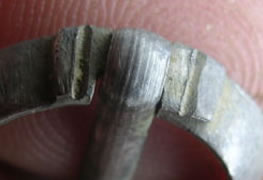









 Another
new set of fields just ploughed and rolled produced several nice Roman
finds including this stunning complete Roman reigns guide off a chariot
or cart. Other great finds included a Medieval circular brooch, this stunning
highly decorated Georgian solid gold cufflink and the first complete 17thC
decorated sword hanger I have seen. Posted more finds to new hunt page
Another
new set of fields just ploughed and rolled produced several nice Roman
finds including this stunning complete Roman reigns guide off a chariot
or cart. Other great finds included a Medieval circular brooch, this stunning
highly decorated Georgian solid gold cufflink and the first complete 17thC
decorated sword hanger I have seen. Posted more finds to new hunt page 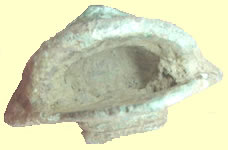


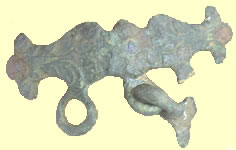












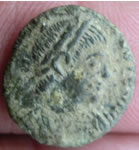


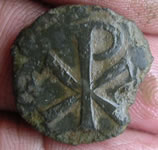

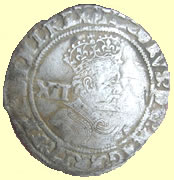

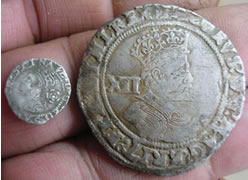



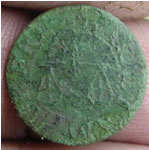
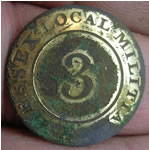






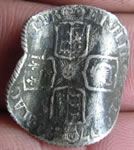
 Unrecorded
6th Regiment of foot button
Unrecorded
6th Regiment of foot button Unrecorded
13th Light dragoons button
Unrecorded
13th Light dragoons button






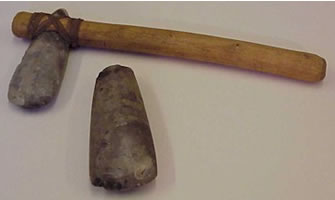



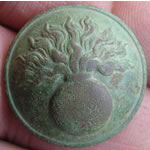







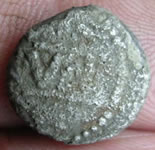









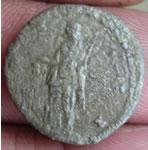
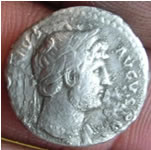
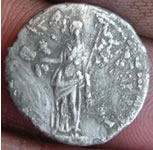





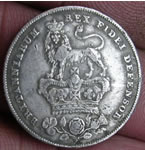


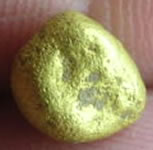
 Les
UK came for a hunt yesterday to meet his USA detecting forum buddies.
Les has some serious Celtic sites of his own in Kent and bought up a wholes
series of Celtic gold and silvers to show the guys. We were all hunting
a new Celtic village site we discovered recently and Les found this amazing
gold nugget. It weights 2.17g,and is approx 6.73mm dia. I took it with
me to the local museum as I was dropping off a bunch of our latest treasures.
The museum took a looked at it and said it should be reported as treasure
so it will now go off to the British museum for tests. It could well turn
out to be a Celtic gold nugget, what a great find. We need to go find
the rest of the nuggets !! Yesterday saw another series of really nice
early hammered silver including this stunning Scottish Alexander III,
first one I have seen. Several very early c13th/14C Jettons were also
found. The museum experts managed to ID an earlier bronze piece that turns
out to be a c1000BC Bronze age casting plug. Uploaded a few more finds
to
Les
UK came for a hunt yesterday to meet his USA detecting forum buddies.
Les has some serious Celtic sites of his own in Kent and bought up a wholes
series of Celtic gold and silvers to show the guys. We were all hunting
a new Celtic village site we discovered recently and Les found this amazing
gold nugget. It weights 2.17g,and is approx 6.73mm dia. I took it with
me to the local museum as I was dropping off a bunch of our latest treasures.
The museum took a looked at it and said it should be reported as treasure
so it will now go off to the British museum for tests. It could well turn
out to be a Celtic gold nugget, what a great find. We need to go find
the rest of the nuggets !! Yesterday saw another series of really nice
early hammered silver including this stunning Scottish Alexander III,
first one I have seen. Several very early c13th/14C Jettons were also
found. The museum experts managed to ID an earlier bronze piece that turns
out to be a c1000BC Bronze age casting plug. Uploaded a few more finds
to 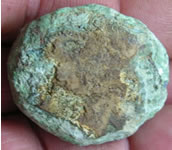























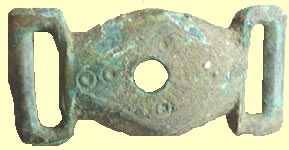





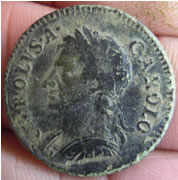





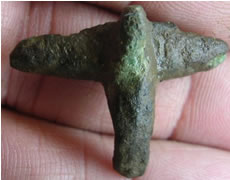




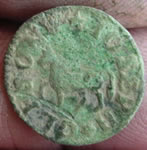



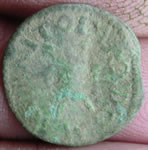







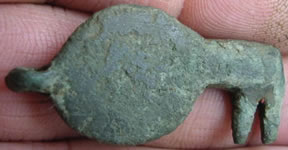
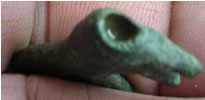

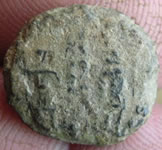





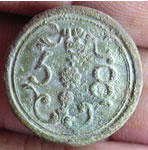
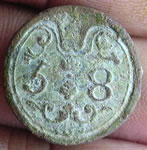
























 'The
quick answer is that it's Trajan, 97-117 A.D. (Hadrian's predecessor)
and so has every good reason to be in Britain. Given the diameter and
weight, it would be an As - also, although perhaps just a tad heavy for
an As at nearly 13gm, I see no traces of the radiate crown which would
indicate that it was a Dupondius (2 Asses).
'The
quick answer is that it's Trajan, 97-117 A.D. (Hadrian's predecessor)
and so has every good reason to be in Britain. Given the diameter and
weight, it would be an As - also, although perhaps just a tad heavy for
an As at nearly 13gm, I see no traces of the radiate crown which would
indicate that it was a Dupondius (2 Asses).